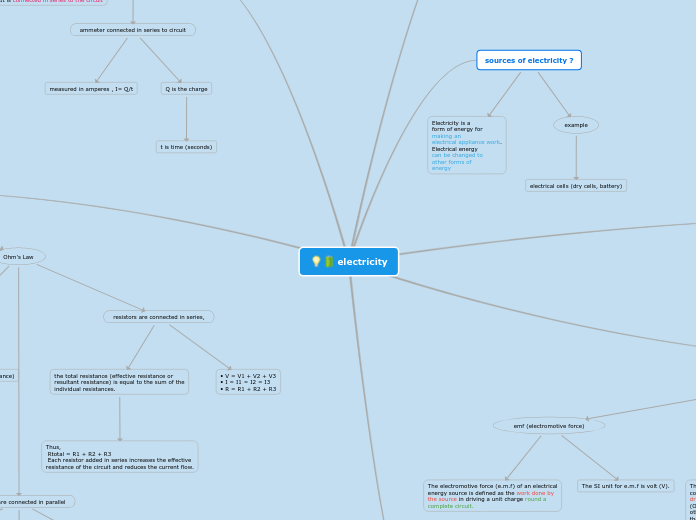
An electric current is the rate
of flow of charge in a circuit.
(amount of charge moving
past any point in a circuit
per second)
The electric cell in a circuit
gives energy to the electrons
and pushes them around a
circuit, from the negative
terminal of the cell, round
the circuit and back to the
positive terminal of the cell
- the direction of conventional current flow is the direction of a
positive charge flow.
- In a circuit, the current is due to the flow of electrons
Electricity is a
form of energy for
making an
electrical appliance work.
Electrical energy
can be changed to
other forms of
energy
example
electrical cells (dry cells, battery)
To make an electrical appliance work, electricity must flow through it. The path along which the electric current moves is called the electric circuit.
Electric circuits are made
up of electrical
components.
• These components
must be joined together
without any gap in
between to form a
closed circuit.
emf (electromotive force)
The electromotive force (e.m.f) of an electrical
energy source is defined as the work done by
the source in driving a unit charge round a
complete circuit.
The SI unit for e.m.f is volt (V).
potential difference (pd)
The potential difference across an electric
component is defined as the work done in
driving a unit charge through the component.
(Or the amount of electrical energy converted to
other forms when a unit charge passes through
the component.)
The SI unit for potential difference is volt (V).
The term potential
difference is used for the
voltage between any two
points in a circuit.
How to measure in a circuit ?
A voltmeter is an instrument used for measuring
potential difference and e.m.f. It is connected in
parallel to the circuit.
Positive (negative)
side of voltmeter is
connected nearest
to the positive
(negative) terminal
of the cell.
The term electromotive
force is used for the voltage
between the two terminals
of a battery or cell.
When an electric current flows through a wire, the
wire heats up. Electrical energy has been
converted into heat energy.
The greater the resistance of the wire, the greater
the amount of heat produced. This heating effect
is used in common electrical appliances.
some examples..
A kettle uses both copper and nichrome wires.
copper wire with
low resistance
produces less
heat
in a bulb, the filament
filament wire produces heat and light
In a light bulb, the heated filament (resistance
wire) becomes so hot that light is also emitted.
Magnetic Effect of an Electric Current
A straight wire is placed near a compass. When
an electric current flows through the wire, the
compass needle is deflected. This shows that an
electric current has a magnetic effect.
An electromagnet consists of a coil of wire usually
wound around a piece of iron. It is a temporary
magnet which can be turned on and off using electric
current.
Chemical Effect of an Electric Current
Electrolysis is the
chemical change that
occurs when an
electric current
passes through
solutions or molten
compounds.
Uses of electrolysis
Metal objects can be plated with a thin layer of
another metal.
ammeter connected in series to circuit
measured in amperes , I= Q/t
Q is the charge
t is time (seconds)
An ammeter is an instrument used for measuring
electric current. It is connected in series to the circuit
relationship between resistance and circuits
The greater the resistance in a circuit, the lower
the current.
The SI unit for resistance is the ohm
Ohm's Law
The current I, passing through a
conductor is directly proportional
to the potential difference, V, between its
ends, provided that physical conditions
and temperature remain constant.
formula
V ( voltage)/I (current) = R (resistance)
resistors are connected in series,
the total resistance (effective resistance or
resultant resistance) is equal to the sum of the
individual resistances.
Thus,
Rtotal = R1 + R2 + R3
Each resistor added in series increases the effective
resistance of the circuit and reduces the current flow.
• V = V1 + V2 + V3
• I = I1 = I2 = I3
• R = R1 + R2 + R3
resistors are connected in parallel
When resistor connected
in parallel ,the total
resistance (or effective
resistance or resultant resistance) is less.
Each resistor added in parallel decreases
the effective resistance of the circuit
and increases the current flow
I = I1 + I2 + I3
Vt = V1 = V2 = V3
1/R = 1/R1 + 1/R2 + 1/R3
• Voltage is the same throughout.
• Current is shared.